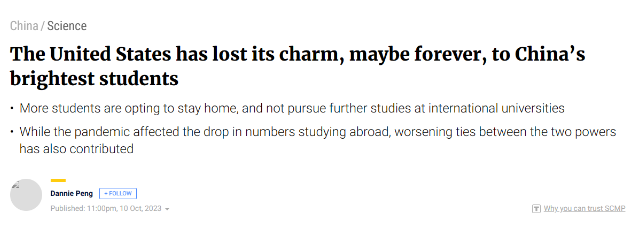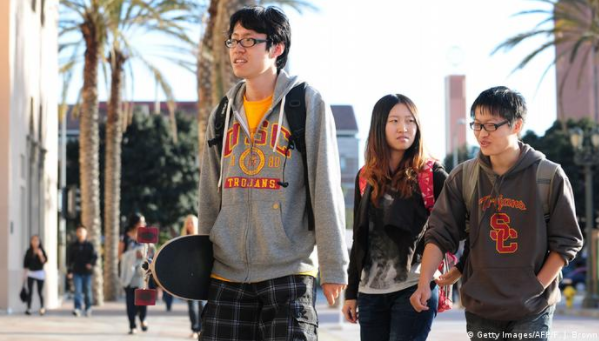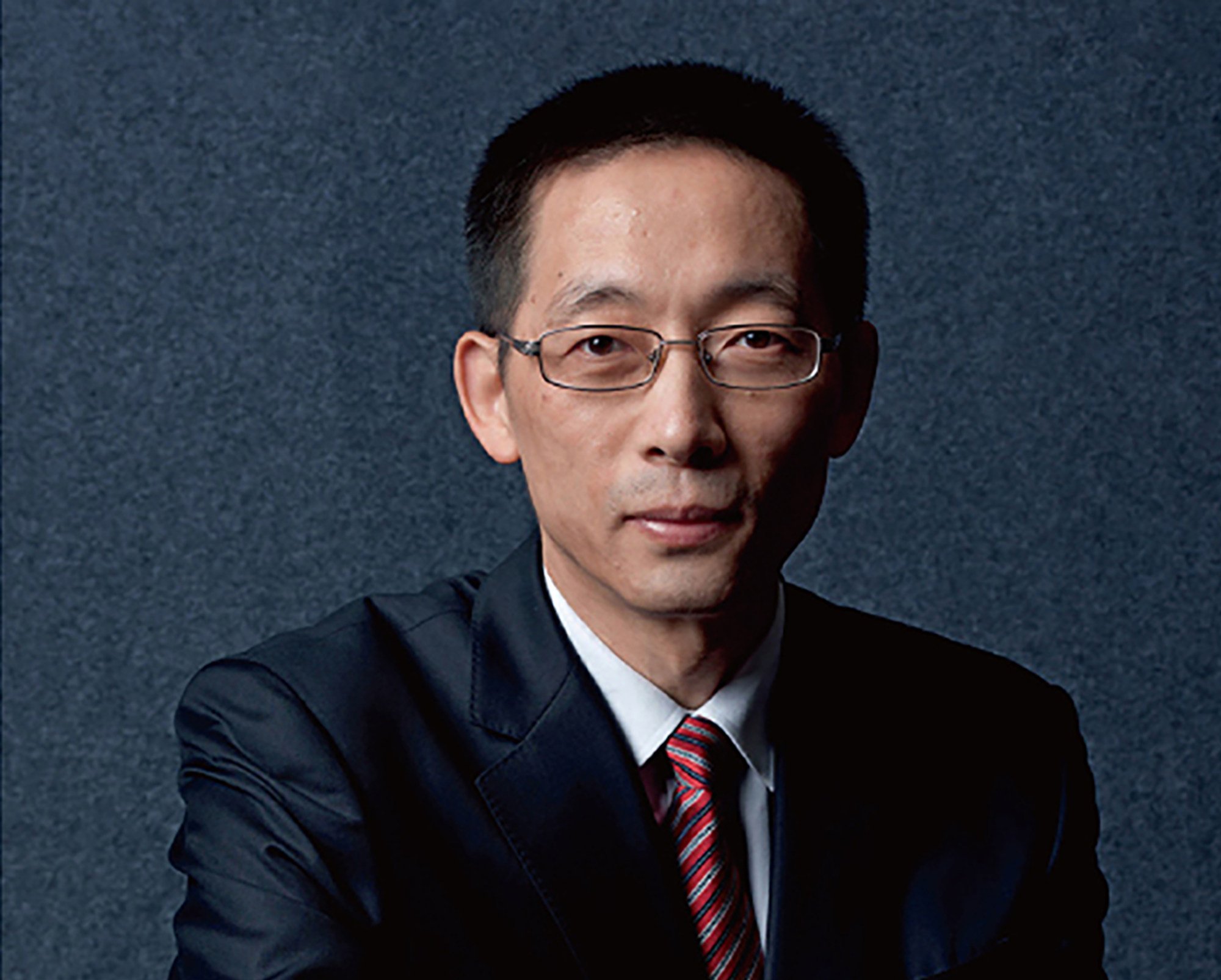风萧萧_Frank
以文会友方向真变了?中国赴美留学生下降
1989年,当结构生物学家施一公从清华大学获得学士学位时,同年毕业的2251名学生中,约有1600人去了美国并留在了那里。
2017年,时任清华大学副校长的施一公在中国中央电视台的一档节目中讲述了这个故事。
如今,情况发生了巨大变化。这一点可以从最新的统计数据中看出:2022年,清华大学本科生和研究生的毕业生中,只有7%的人出国深造。
在3197名本科生中,14%的人选择出国留学,与2017年形成鲜明对比,当时28%的本科生寻求海外教育。在另一所一流学府——北京大学,也可以看到类似的下降趋势。
清华大学一位不愿透露姓名的物理学家表示:“在过去四年里,我们大多数最优秀的学生都选择留在中国,出国的人更少。”
他说,在2019年之前,他所在系近一半的毕业生选择出国留学,主要是前往美国和英国最知名的学府。然而,这一比率一直在显著下降。
《南华早报》称,发生在清华大学的事情反映了一种悄无声息的新兴趋势:尽管出国留学仍然具有吸引力,但越来越多的优秀学生正在排除出国留学的可能性。
根据教育部的数据,自1978年中国改革开放以来,截至2021年底,约有800万中国学生在国外学习。这是一个巨大的数字,他们的流动对双方都具有重要的战略意义。
现在,一些在美国学术界工作的科学家已经感受到了中国留学生数量的减少。
美国乔治亚大学杰出的物理学研究教授赵奕平表示,他所在系过去新招收的学生中有一半以上是华裔,但今年这个数字只有一两个。取而代之的是来自尼泊尔和孟加拉国等发展中国家的候选人。
“我们希望录取更多的中国学生,因为一般来说,他们有更坚实的学术基础,”赵说。
中国持续了大约三年的动态清零防疫政策对这一转变造成了直接影响。
The United states has lost its charm, maybe forever
(截图自南华早报)
北京大学教育学院副教授沈文钦说:“大流行是一种破坏,但它不是主要原因。”他补充说,这种下降在过去两年尤为明显。
沈文钦自2016年以来一直在观察这个问题。他说,大约5、6年前,在中国最好的大学主修数学、物理和化学等学科的最聪明的学生将海外留学视为他们职业阶梯上的最佳下一步。
但这种趋势正在消退。2020年,时任清华大学校长邱勇指出,在过去的五年里,清华大学毕业生出国留学的比例逐年下降。
他说:“越来越多的毕业生选择留在中国继续深造或进入就业市场。”
在国外,中美关系的恶化给一些学生的美国教育梦想蒙上了阴影,导致他们推迟了学习计划,主要原因是签证审批更加严格。

根据美国《高等教育纪事报》(Chronicle of Higher Education)的数据,2022年年中,美国向中国学生发放的签证比2021年同期减少了45%左右。尽管如此,对于许多中国家庭来说,在国际知名的高等教育机构学习仍然是一个诱人的梦想。
《外交事务》杂志上个月发表的一篇文章称:“美国大学促进国家间相互理解的最重要方式之一,同时也促进了美国的利益,就是培养来自世界各地的学生。”文章还补充说,美国大学吸引世界上最优秀人才的能力是美国成功的关键。
根据市场研究公司ICEF Monitor的数据,2022年,约有130万国际学生在美国持有有效学习签证,比2021年增长了10%。中国仍然是最大的来源国,约有32万名学生前往美国。
The United States has lost its charm, maybe forever, to China’s brightest students
- More students are opting to stay home, and not pursue further studies at international universities
- While the pandemic affected the drop in numbers studying abroad, worsening ties between the two powers has also contributed
This story was told in 2017 by Shi, who was vice-president of Tsinghua University at the time, in a programme broadcast by China’s state-owned CCTV.
He said that before 2019, nearly half the graduates from his department would opt to study abroad, mainly heading to the best-known institutions in the United States – such as its Ivy League universities – as well as Britain. However, that rate has been declining significantly.
What has happened at Tsinghua University is a reflection of a quiet, emerging trend: despite studying abroad remaining appealing, an increasing number of high academic achievers are ruling it out.
Since China’s reform and opening up in 1978 until the end of 2021, around 8 million Chinese students have studied abroad, according to the Ministry of Education. This is a huge number and their flow is strategically important for both sides.
Zhao Yiping, a distinguished research professor of physics at the University of Georgia in the US, said more than half of the newly recruited students in his department used to be of Chinese origin, but this year that number is just one or two. Candidates from developing countries such as Nepal and Bangladesh are filling the spots instead.
“We want to hire more Chinese students because generally, they have a more solid academic foundation,” Zhao said.
China’s zero-Covid policy, which lasted for around three years, directly affected this shift.
“The pandemic is a disruption, but it is not the main reason,” said Shen Wenqin, an associate professor from the school of education at Peking University, adding that the decline had been particularly pronounced in the last two years.
Shen has been observing this issue since 2016. He said that around five or six years ago, the smartest students who majored in subjects such as mathematics, physics and chemistry at China’s best universities saw overseas study as the optimal next step on their career ladder.
But it is a trend that has been fading. In 2020, Qiu Yong, then-president of Tsinghua University, pointed out that in the previous five years, the proportion of the institution’s graduates studying abroad had declined more each year.
“More and more graduates choose to stay in China to further their studies or go to the job market,” Qiu said.
Externally, worsening relations between the US and China have cast a shadow over some students’ American education dreams, leaving them putting off their study plans, mainly as a result of a tougher visa approval.

In mid-2022, the US issued around 45 per cent fewer visas to Chinese students compared with the same period in 2021, according to the US-based Chronicle of Higher Education.
However, researchers interviewed by the Post attached more importance to the fact that, unlike where China was at the start of the century, the nation is now becoming a major global powerhouse of science and technology.
Shen has conducted interviews with students from top mainland universities in recent years, and they listed the Western-trained teachers as a reason why they were now looking at continuing their studies or conducting research in China.
“If you have a scan at the résumés of faculty at such institutions, you will find that many younger generation scholars are armed with a background at the most prestigious schools like Stanford, MIT or Harvard, and therefore they have a worldly horizon and international collaboration network,” he said.
In the same vein, China has been upgrading its industrial structure to grow into a more technologically advanced economy and thus has created more hi-tech jobs for young professionals.
“One of the most important ways that American universities promote mutual understanding between countries – while also advancing US interests – is by educating students from around the world,” a Foreign Affairs article published last month said, adding that the ability of American universities to attract the world’s best talent was key to the country’s success.
But, what implications will it bring for China? Academics interviewed expressed a cautious but positive sentiment towards the change.
“China is not as reliant on the West in talent training as it was in the past,” Zhao said.
In Shen’s opinion, the shift is in fact a good thing for China.
“I think in the past we were experiencing a sort of talent drain as the best brains went abroad and a high proportion of them no longer came back, which was in return hurting China’s talent training system,” he said.
But if the rate continued to drop, Shen said there would be a reason to be worried, as one of the key contributions to China’s scientific development over the last few decades has come from sending young talent to developed countries and maintaining academic exchange with the world.
That said, studying in well-known international higher education institutions is still a tantalising dream for many Chinese families.
According to data from market research firm ICEF Monitor, in 2022, around 1.3 million international students held valid study visas in the United States, a 10 per cent increase compared to 2021. China remained the largest source country, with around 320,000 students heading to America.
A vaccine development scientist at a mainland university, who spoke on condition of anonymity, observed that some college students, especially those from less privileged backgrounds, were no longer as keen to pursue further education in the US, under the converging influences of the negative portrayal of the country by Chinese media, the hype about China’s technological prowess, and anti-Asian hate crimes in the US.
However China’s elite group, he said, was increasingly prioritising international education for their children. He said a close friend, a famous scientist who intended to send his child to a US university, had decided to bring that plan forward, opting to send them there for high school.
The vaccine expert said he could understand such a decision, as he has become disappointed with the fostering of talent in mainland universities.
“Many irrelevant political ideology courses are consuming a significant portion of students’ time, while major-related materials and knowledge imparted are outdated,” he said, adding that the intensifying restrictions on freedom of expression and exploration had hindered innovation.
He said that despite significant advancements in science and technology in China, there was a considerable gap when compared to some Western countries, citing the proliferation of Chinese biotech companies in recent years as an example.
“Many of them lack original technologies,” he said.






